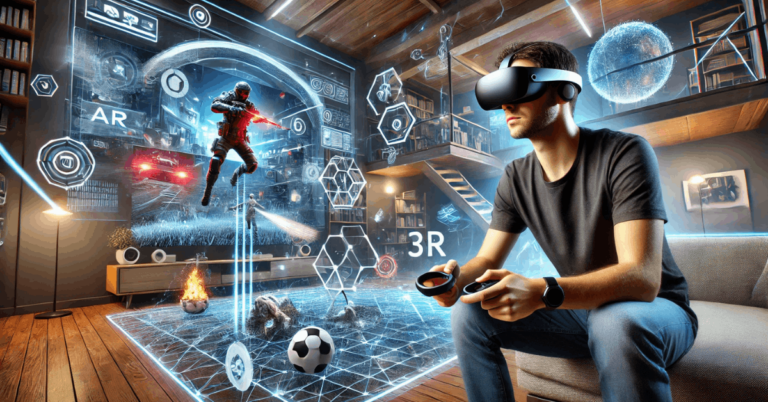Tech innovation in AI and AR is transforming industries with smarter automation and immersive digital experiences.
In 2025, these technologies will drive significant healthcare, retail, and education advancements.
This article explores their latest developments, practical applications, and future challenges.
Current State of AI and AR
The current state of AI and AR showcases rapid advancements and their growing influence across industries.
Below are key developments that highlight how these technologies are shaping 2025:
- AI-powered Tools: Widespread use of natural language processing and predictive analytics.
- Advanced AR Hardware: Lighter, more efficient AR headsets and devices.
- AI Industry Adoption: Integration in healthcare, finance, and automation.
- AR Applications Growth: Expanded use in retail, gaming, and education.
- AI-AR Integration: Combined technologies creating personalized experiences.
- Global Investments: Increased funding driving innovation in AI and AR.
- Ethical Concerns: Focus on privacy, bias, and regulatory challenges.

Key Innovations in AI
AI drives significant breakthroughs, transforming industries and enabling smarter, more efficient solutions.
Here are some key innovations shaping the future of AI:
- Generative AI: Models like ChatGPT and DALL-E create human-like text, images, and content.
- Autonomous Systems: Advancements in robotics and self-driving technology.
- AI in Healthcare: AI-powered diagnostics and personalized treatment planning.
- Edge AI: Real-time processing on devices without relying on cloud infrastructure.
- Explainable AI: Tools improving transparency and understanding of AI decision-making.
- AI for Sustainability: Solutions optimizing energy use and supporting green initiatives.
- Advanced NLP: Improved language models enabling better human-AI interaction.
Key Innovations in AR
AR is evolving rapidly, introducing innovations, transforming user experiences, and expanding applications across industries.
Here are the key advancements in AR shaping 2025:
- AR Wearables: Lightweight, high-performance AR glasses and headsets.
- AR Cloud: Persistent AR experiences through shared digital environments.
- AI-powered AR: Enhanced object recognition and real-time interaction.
- AR in Retail: Virtual try-ons and immersive shopping experiences.
- AR for Training: Interactive simulations for skill development and education.
- Mixed Reality (MR): Seamless blending of AR with real-world environments.
- AR Gaming and Entertainment: Immersive, location-based AR experiences.
Integration of AI and AR
The integration of AI and AR is unlocking new possibilities, combining AI’s intelligence with AR’s immersive experiences.
This synergy boosts functionality, personalizes interactions, and transforms industries. Key aspects include:
- Enhanced Object Recognition: AI enables AR to identify and track objects in real-time, enhancing accuracy and interaction.
- Smart Virtual Assistants: AI-driven assistants within AR environments provide context-aware guidance and support.
- Immersive Training Simulations: AI enhances AR training by personalizing simulations based on user performance and needs.
- AR Shopping Experiences: AI analyzes user preferences while AR visualizes products, creating tailored retail experiences.
- Interactive Education Tools: AI adapts AR educational content to suit individual learning styles.
- Healthcare Innovations: AI assists AR in medical imaging, surgery, and rehabilitation applications.
- Data-Driven Insights: AI processes AR-generated data for actionable insights in industries like manufacturing and logistics.
Impact on Specific Industries
AI and AR drive significant transformations across various industries, improving efficiency, innovation, and user experiences. Key impacts include:
- Healthcare: AI-powered AR enhances diagnostics, surgery precision, and medical training through real-time visualization.
- Retail: AR-driven virtual try-ons and personalized AI recommendations revolutionize shopping experiences.
- Education: Interactive AR tools supported by AI personalize learning and improve engagement.
- Entertainment: AI-AR integration creates immersive gaming, virtual concerts, and interactive storytelling.
- Manufacturing: AR-guided assembly lines and AI-powered predictive maintenance streamline operations.
- Real Estate: Virtual property tours using AR with AI insights improve client interactions and decision-making.
- Logistics: AI analyzes AR-driven data for better inventory management and delivery optimization.

Challenges and Ethical Considerations
While AI and AR bring transformative benefits, they also introduce challenges and ethical considerations that must be addressed. Key concerns include:
- Privacy Issues: Potential misuse of personal data collected by AI and AR systems.
- Bias in AI: Risk of perpetuating discrimination through biased algorithms.
- Accessibility: Limited access to AI and AR technologies due to high costs.
- Regulation Gaps: Lack of clear policies governing the use of these technologies.
- Job Displacement: Automation replacing human roles in specific industries.
- Overreliance on Technology: Risk of reduced critical thinking and human creativity.
- Environmental Impact: High energy consumption in AI training and AR hardware production.
Role of Startups
Startups are critical in driving innovation in AI and AR by introducing fresh ideas and disrupting traditional markets.
Their agility allows them to experiment with cutting-edge technologies and deliver rapid advancements. Key contributions from startups include:
- Specialized Solutions: Startups focus on niche markets, developing tailored AI and AR applications for specific industries.
- Rapid Prototyping: Smaller teams enable faster development cycles and innovation.
- Collaboration with Tech Giants: Startups often partner with larger companies to scale their solutions and reach global markets.
- Open Innovation: Many startups embrace open-source platforms, accelerating technological progress.
- Driving Competition: By challenging established players, startups push the boundaries of what AI and AR can achieve.
- Focus on Affordability: Startups often prioritize cost-effective solutions, making technologies accessible to smaller businesses and individuals.
- Attracting Investment: Startups are a key focus for venture capitalists, fueling the rapid growth of AI and AR ecosystems.
Investment Trends in AI and AR
Investment in AI and AR continues to surge, reflecting their transformative potential across industries. Key trends in funding and development include:
- Venture Capital Growth: AI and AR startups attract significant venture capital, particularly in healthcare, retail, and gaming.
- Corporate Funding: Large tech companies are leading funding rounds to accelerate innovation and acquire promising startups.
- Government Initiatives: Many governments prioritize AI and AR funding to boost national innovation and competitiveness.
- Focus on Emerging Markets: Investors target developing regions with untapped AI and AR potential.
- Cross-Industry Investment: Funding is diversifying, with industries like real estate, logistics, and education increasing investments in AI and AR.
- Sustainability Projects: AI and AR projects promoting environmental and energy efficiencies are receiving growing attention.
- Record-Breaking Deals: Mega-funding rounds and acquisitions highlight confidence in these technologies’ long-term impact.
Security Risks
The rise of AI and AR introduces new security risks that must be addressed to ensure safe and responsible use.
These risks span from data vulnerabilities to potential misuse of the technologies. Key security challenges include:
- Data Privacy Breaches: AI and AR systems collect vast amounts of personal data, increasing risks of unauthorized access and misuse.
- Deepfake Technology: AI-generated deepfakes can spread misinformation and compromise trust.
- Hacking and Exploitation: AR devices and AI algorithms are vulnerable to cyberattacks, potentially exposing sensitive data.
- Identity Theft: AI-powered AR applications using biometric data can be exploited for identity fraud.
- Unauthorized Surveillance: AR integrated with AI may enable covert monitoring without user consent.
- Manipulated AR Environments: Malicious actors can alter AR content to mislead or harm users.
- Lack of Regulation: Insufficient policies and standards increase the risk of technology misuse.
Future Outlook
The future of AI and AR holds immense potential, with advancements set to reshape industries and daily life. Key predictions for their evolution include:
- Deeper AI-AR Integration: Enhanced collaboration for smarter and more immersive experiences.
- Mainstream Adoption: Increased use of AI and AR across industries and consumer markets.
- Affordable Technologies: Lower costs, making AI and AR accessible to more users.
- Ethical AI Standards: Development of global guidelines to address privacy and bias.
- Smarter Personalization: AI delivering hyper-personalized AR experiences.
- Sustainability Focus: Green AI and AR solutions reducing environmental impact.
- Education and Workforce Transformation: AI and AR redefining learning and job training methods.
To Sum Up
AI and AR are revolutionizing industries, offering innovative solutions and immersive experiences that redefine possibilities.
While challenges like privacy and ethics remain, their innovation potential is unparalleled.
Embracing these technologies responsibly will ensure a future where their benefits are maximized for all.


